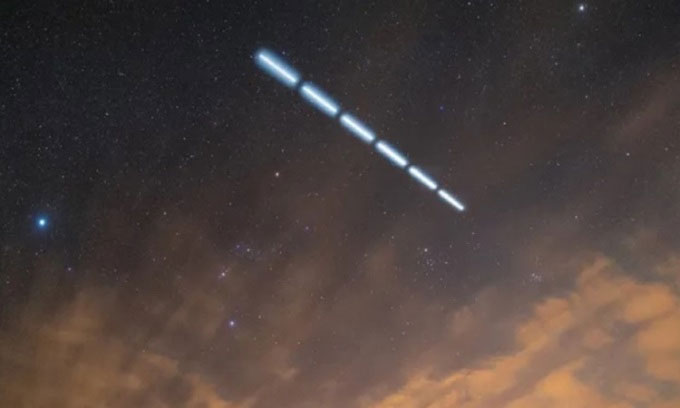SpaceX rocket creates strange hyphen in the sky
A photographer shares a glowing streak of dashes in the night sky above Arizona after part of a Falcon 9 rocket fell back to Earth.
The American photographer's photos capture the perfect dash that the SpaceX rocket created in Arizona. The new image is a reminder of the company's hectic rocket launch schedule, Live Science reported on April 3.

The intermittent streak of light created by the second stage of the Falcon 9 rocket falling to Earth. (Photo: Jeremy Perez).
On March 30, SpaceX launched two Falcon 9 rockets less than 4 hours apart. The first rocket, carrying the Eutelsat 36D telecommunications satellite , took off at 5:52 p.m. from the Kennedy Space Center (KSC) in Florida. The second rocket carried 23 of the company's Starlink satellites , launched from the Cape Canaveral Space Force Center next to KSC, at 9:30 p.m. local time.
After releasing the payload, the rocket's second stage, the main part separated from the rocket's reusable booster stage, left orbit, fell to Earth and burned up in the planet's upper atmosphere. Initially, photographer Jeremy Perez planned to capture the deceleration and reentry process of the first rocket from a location near his home in Flagstaff, Arizona but failed due to too thick clouds. But when the second rocket began the same maneuver, the sky cleared and Perez captured a beautiful image of the rocket fragment falling to Earth.
In the new photo, Perez combines multiple long exposure shots of the burning second stage as it flies overhead. The gaps between the streaks of light represent where the camera's shutter closes. In real time, the event looked very different. Perez describes it as looking like a delicate dandelion petal floating in the air. The light is also white in reality instead of light blue like in the photo. In the enlarged version of the photo, a second long, fainter streak can be seen next to the falling piece of space junk. It is the light emitted by the satellite that the rocket deployed, flying with it before starting its final maneuver.
On April 1, a Falcon 9 rocket took off from Vandenburg Space Force Base in California, then deployed 22 additional Starlink satellites in orbit. The company also plans to launch two more Falcon 9 rockets on April 5 and April 7 to send satellites into space. The increasing number of SpacX rocket launches increases the likelihood of people seeing orbital material or other phenomena caused by falling rockets, such as light vortexes created by rocket fuel. frozen from the Falcon 9 booster stage.
For example, on March 4, one such vortex was even brighter than the aurora borealis for a short time in many parts of the Arctic. Falcon 9 rockets can be seen kilometers away as they fly into the air and sometimes blow holes in the upper atmosphere, leaving behind a bright red streak that resembles an aurora borealis.
- SpaceX is about to launch the world's most powerful rocket
- A SpaceX rocket engine exploded during testing
- The greatest landmarks in SpaceX history
- The SpaceX rocket landed after a historic flight
- SpaceX announced the cause of the Falcon 9 rocket exploding
- SpaceX rocket suddenly exploded just before the launch time
- SpaceX's test missile caught fire on the launch pad
- Elon Musk's Starship rocket exploded
- Tomorrow, SpaceX will change history with the mission of releasing Falcon 9 missiles
- SpaceX missile re-launches set two records in one day
- SpaceX Grasshopper reached a new height record
- NASA was not satisfied with the launch of SpaceX's new rocket
 Van Allen's belt and evidence that the Apollo 11 mission to the Moon was myth
Van Allen's belt and evidence that the Apollo 11 mission to the Moon was myth The levels of civilization in the universe (Kardashev scale)
The levels of civilization in the universe (Kardashev scale) Today Mars, the sun and the Earth are aligned
Today Mars, the sun and the Earth are aligned The Amazon owner announced a secret plan to build a space base for thousands of people
The Amazon owner announced a secret plan to build a space base for thousands of people Good at 'copying technology', Vietnam's neighbor is accelerating: About to surpass the US?
Good at 'copying technology', Vietnam's neighbor is accelerating: About to surpass the US?  Chinese companies challenge SpaceX
Chinese companies challenge SpaceX  Mountains become space junk dumping grounds
Mountains become space junk dumping grounds  Russia announced successful launch of Soyuz-2.1b rocket
Russia announced successful launch of Soyuz-2.1b rocket  Japan experiences problems during Epsilon S rocket engine test
Japan experiences problems during Epsilon S rocket engine test  US student's amateur rocket reaches record height
US student's amateur rocket reaches record height 